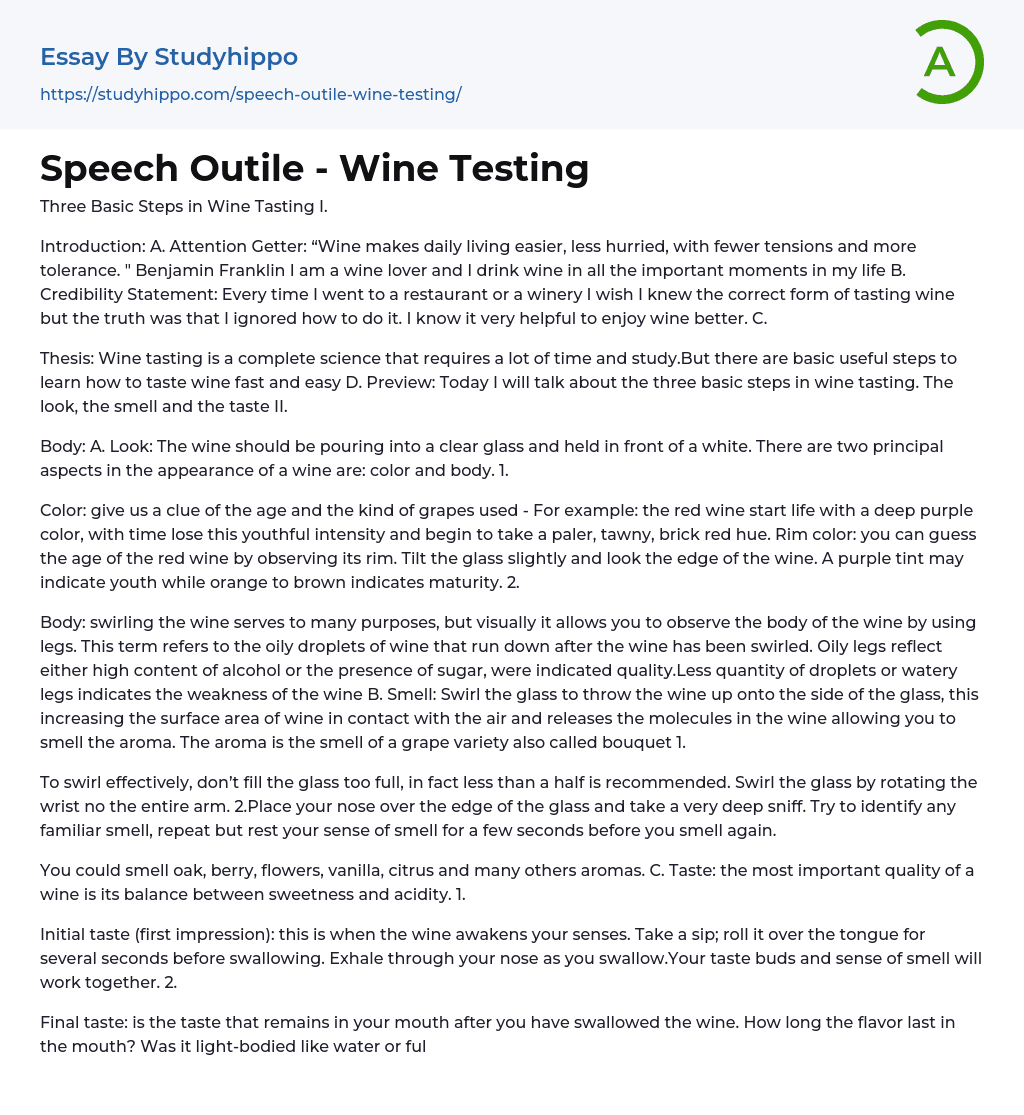The process of wine tasting consists of three essential steps, which are:
- Visual examination
- Olfactory inspection
- Gustatory assessment
Introduction:
A. Being a wine lover, I have always believed in Benjamin Franklin's statement that wine can enhance our daily life and make it more enjoyable. Wine has accompanied me throughout all the important moments of my life.
B. Nevertheless, I frequently found myself at wineries or restaurants struggling to taste and appreciate the wines presented to me. It was only later that I realized how essential it is to learn how to properly taste wine in order to enjoy it fully.
C.
The thesis discusses the intricacies of wine tasting, which require extensive study and dedication. Nevertheless, there are basic techniques that can be adopted for a speedy and effecti
...ve learning experience. The presentation will encompass three pivotal phases in wine tasting: visual assessment, scent evaluation, and taste analysis.
Body: A. The wine should be poured into a clear glass and held in front of a white background to observe its appearance. Two important elements to consider in the appearance of wine are its color and body. 1.
The color of wine indicates the age and type of grapes used. Red wine starts with a deep purple color which fades over time to a paler, tawny, brick red hue. The rim color can also help guess the age of red wine - tilt the glass slightly to observe the edge of the wine. A purple tint may indicate youth while orange to brown indicates maturity.
Swirling wine has multiple benefits. Firstly, it visually allows you to examine the wine's body with legs - oily droplets that run down after swirling. Th
presence of oily legs indicates high alcohol content or sugar levels, which signifies quality. Weak wines have fewer droplets or watery legs. Secondly, swirling helps release the molecules in the wine and increase its surface area, allowing you to smell its aroma - also known as bouquet 1 - which is specific to the grape variety.
For optimal swirling, fill the glass to less than half and rotate your wrist instead of your whole arm. To properly smell the drink, position your nose over the edge of the glass and take a deep breath. Note any detectable scents but give your sense of smell a few seconds to rest before trying to identify more.
Wine has a range of scents including oak, berry, flowers, vanilla, and citrus. However, the key element of wine is achieving a harmonious balance between sweetness and acidity.
When sampling wine, it is important to concentrate on the initial taste because it stimulates the senses. To achieve this, it is suggested to take a sip and retain the wine in your mouth before swallowing. As you exhale through your nose, your sense of smell and taste collaborate to provide a complete sensory encounter.
One should be attentive to the aftertaste duration and flavor intensity of wine. Evaluating its taste balance is also important to identify preferred wines for future purchases.
To put it briefly, acquiring the skill of wine tasting requires guidance and entails three crucial steps: observing, smelling, and sampling. As California residents - the top state for wine production in the U.S. and fourth worldwide - we have access to numerous wineries. Therefore, I recommend exploring all the pleasures that wine has to
offer by putting your newfound knowledge into practice.
- Adaptation essays
- Adventure essays
- Adversity essays
- Aging essays
- Alcohol essays
- Barbie Doll essays
- Beauty essays
- Care essays
- Carpe diem essays
- Change essays
- Chess essays
- Chicken essays
- Choices essays
- Contrast essays
- Crops essays
- Development essays
- Dream essays
- Evil essays
- Experience essays
- Family essays
- Farm essays
- Fire essays
- First Love essays
- Focus essays
- Greed essays
- Hero essays
- Holiday essays
- House essays
- Housing essays
- Humility essays
- Humor essays
- Hypocrisy essays
- Integrity essays
- Law of Life essays
- Life Changing Experience essays
- Life Experience essays
- Lifestyle essays
- Limitations essays
- Love Story essays
- Mother Tongue essays
- Motherhood essays
- My Neighborhood essays
- Myself essays
- Mystery essays
- Narcissism essays
- Never Give Up essays
- Nursing essays
- Object essays
- Opportunity essays
- Peel essays




